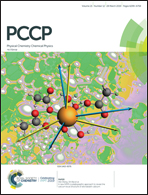Gold substrates of controlled roughness and electrokinetic properties formed by nanoparticle deposition†
Abstract
The kinetics of positively charged gold nanoparticle self-assembly on oxidized silicon substrates (wafers) under diffusion-controlled transport was studied using scanning electron microscopy (SEM) and atomic force microscopy (AFM). The latter technique allowed the roughness parameters of the monolayer (root mean square) to be determined as a function of the particle coverage. These results were adequately interpreted in terms of a theoretical model developed for surfaces covered by features of spherical shape considering the tip convolution effect. The stability and the electrokinetic characteristics (zeta potential) of the monolayers were also acquired using streaming potential measurements. It was shown that the inversion of the negative zeta potential of the bare substrate (overcharging) occurs at the particle coverage equal to 0.15, and for larger coverages positive zeta potential values were asymptotically attained. Additionally, the desorption kinetics of the particles was investigated by the streaming potential method, which confirmed the stability of the monolayers for a broad range of pHs. It was argued that these results enable to develop an efficient method for the preparation of gold sensors exhibiting a well-controlled surface roughness and electrostatic charge comprising both negative and positive values.



 Please wait while we load your content...
Please wait while we load your content...